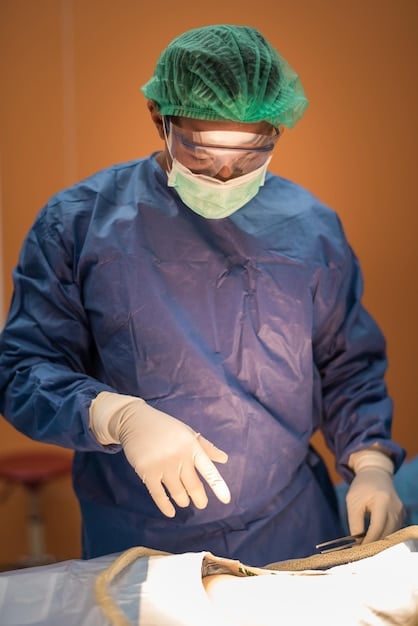Male Breast Reduction: Gynecomastia Surgery Options in 2025

Male breast reduction, or gynecomastia surgery, in 2025 includes advanced liposuction, excision techniques, and combination approaches to remove excess fat and glandular tissue, reshaping the chest for a more masculine contour with minimal scarring.
Male breast reduction (gynecomastia) surgery is becoming increasingly popular. If you’re considering this procedure in 2025, it’s essential to understand the latest surgical options available to correct enlarged male breasts and achieve a more sculpted chest.
Understanding Gynecomastia: An Overview
Gynecomastia, the enlargement of male breast tissue, can affect men of all ages. Understanding its causes and the emotional impact it can have is crucial before exploring surgical options.
What Causes Gynecomastia?
Gynecomastia can arise from various factors, leading to an imbalance in hormones. Common causes include:
- Hormonal Imbalance: An increase in estrogen relative to testosterone.
- Medications: Certain drugs like antidepressants, anti-anxiety medications, and anabolic steroids.
- Medical Conditions: Conditions like Klinefelter syndrome, hyperthyroidism, and liver disease.
- Age: Hormonal changes during puberty and older age.
Identifying the underlying cause can help determine the most appropriate treatment plan.
The Psychological Impact of Enlarged Male Breasts
Beyond the physical aspect, gynecomastia can have a significant psychological impact. Men may experience:
- Decreased Self-Esteem: Feeling self-conscious about their appearance.
- Social Anxiety: Avoiding situations where they might feel exposed, like swimming or changing rooms.
- Body Image Issues: Constant preoccupation with their chest appearance.
Male breast reduction (gynecomastia) surgery can alleviate these emotional burdens by restoring a more masculine chest contour.
Gynecomastia is a multifactorial condition that affects both physical and emotional well-being. Recognizing the causes and psychological impact is the first step in seeking effective treatment options to improve one’s quality of life.
Initial Consultation and Assessment
Before undergoing male breast reduction (gynecomastia) surgery, a thorough consultation and assessment are necessary to determine the best surgical approach. Here’s what to expect:
Medical History and Physical Examination
During the consultation, the surgeon will review your medical history, including any medications, allergies, and previous surgeries. A physical examination will assess the size and shape of your breasts, skin elasticity, and overall health. This helps determine the degree of gynecomastia and any underlying conditions.
Discussing Your Goals and Expectations
Open communication is key. Discuss your goals and expectations for the surgery. The surgeon will explain what can realistically be achieved and any potential limitations. This ensures you have a clear understanding of the procedure and its outcomes.
The initial assessment is a crucial step in planning the surgery, ensuring the best possible results that align with the patient’s expectations. It is important for patients to be honest, upfront, and discuss all concerns, as well as their expectations.

Liposuction Techniques for Gynecomastia
Liposuction is a common technique used in male breast reduction (gynecomastia) surgery to remove excess fat. It can be used alone or in combination with other surgical methods to achieve the desired chest contour. Here’s a breakdown of liposuction techniques:
Traditional Liposuction
Traditional liposuction involves making small incisions and inserting a cannula (a thin tube) to suction out fat. This method is effective for removing significant amounts of fat but may not be suitable for cases with excess glandular tissue.
Ultrasound-Assisted Liposuction (UAL)
UAL uses ultrasound energy to liquefy fat before it is suctioned out, making it easier to remove. This technique is particularly useful for fibrous or dense breast tissue. It also stimulates collagen production, which can improve skin elasticity.
Power-Assisted Liposuction (PAL)
PAL uses a vibrating cannula to break up fat cells, making them easier to remove. This technique is less aggressive than traditional liposuction and can result in smoother results and reduced recovery time.
The choice of liposuction technique depends on the individual’s anatomy and the extent of fat removal required. Consulting with a skilled surgeon ensures the most appropriate method is used for optimal outcomes.
Excision Techniques for Gynecomastia
In cases where gynecomastia involves excess glandular tissue or skin, excision techniques are necessary. These methods remove the tissue directly, reshaping the chest for a more masculine appearance.
Direct Excision
Direct excision involves making an incision around the areola and removing excess glandular tissue and skin. This technique is effective for moderate to severe gynecomastia, providing significant improvement in chest contour.
Periareolar Excision
Periareolar excision involves making an incision around the edge of the areola to remove excess tissue. This approach is suitable for milder cases of gynecomastia and can result in minimal visible scarring.
Combination Techniques
In some cases, a combination of liposuction and excision is used. Liposuction removes excess fat, while excision removes excess glandular tissue and skin. This approach provides comprehensive reshaping, resulting in a natural-looking chest.
- Liposuction: Removes excess fat for a contoured chest.
- Excision: Removes excess glandular tissue and skin.
- Combination: Liposuction plus excision providing comprehensive reshaping.
Choosing the right excision technique depends on the individual’s anatomy and the extent of tissue removal required. A skilled surgeon can tailor the approach for optimal aesthetic outcomes.
Minimally Invasive Approaches
Minimally invasive techniques are gaining popularity in male breast reduction (gynecomastia) surgery due to their reduced scarring and faster recovery times. These approaches offer effective results with less downtime.
Endoscopic Gynecomastia Surgery
Endoscopic surgery involves making small incisions and using an endoscope (a thin tube with a camera) to guide the surgical instruments. This technique is suitable for removing glandular tissue with minimal scarring.
Laser-Assisted Liposuction
Laser-assisted liposuction uses laser energy to liquefy fat and tighten skin. This technique is less invasive than traditional liposuction and can result in smoother results and reduced recovery time.
Benefits of Minimally Invasive Techniques
Minimally invasive approaches offer several benefits:
- Reduced Scarring: Smaller incisions result in less visible scars.
- Faster Recovery: Less tissue trauma leads to quicker healing.
- Lower Risk of Complications: Minimally invasive techniques reduce the risk of infection and other complications.
These benefits make minimally invasive approaches an attractive option for men seeking male breast reduction (gynecomastia) surgery.
Recovery and Aftercare
Proper recovery and aftercare are essential for achieving the best results after male breast reduction (gynecomastia) surgery. Following the surgeon’s instructions can minimize complications and ensure a smooth healing process.

Post-Operative Care
Immediately after surgery, you will be placed in a compression garment to reduce swelling and support the healing tissue. Pain medication will be prescribed to manage any discomfort. It is important to follow all instructions and attend follow-up appointments.
Managing Swelling and Bruising
Swelling and bruising are common after surgery. To minimize these effects:
- Wear the compression garment as directed.
- Apply cold compresses to the chest.
- Elevate your upper body while resting.
Resuming Normal Activities
Most men can return to light activities within a week after surgery. Strenuous exercise and heavy lifting should be avoided for at least four to six weeks. Gradual resumption of activities will help prevent complications and promote healing.
Following post-operative instructions is critical for optimal results. If you have any concerns or experience unusual symptoms, contact your surgeon immediately.
Expected Results and Long-Term Outcomes
Understanding the expected results and long-term outcomes of male breast reduction (gynecomastia) surgery is crucial for setting realistic expectations. Here’s what you can anticipate:
Immediate Changes
Immediately after surgery, you will notice a more contoured chest. Swelling and bruising will gradually subside over the following weeks, revealing the final results. The compression garment helps maintain the new shape during the healing process.
Long-Term Benefits
Long-term benefits include:
- Improved Chest Contour: A flatter, more masculine chest appearance.
- Increased Self-Esteem: Enhanced body image and confidence.
- Better Clothing Fit: Clothes fit better and more comfortably.
These lasting benefits can significantly improve your quality of life.
Maintaining Results
To maintain the results of your surgery, it is important to maintain a healthy lifestyle. This includes:
- Maintaining a stable weight.
- Avoiding medications and substances that can cause gynecomastia.
- Regular exercise to maintain muscle tone.
These measures will help ensure long-term satisfaction with your surgical outcomes.
| Key Point | Brief Description |
|---|---|
| 💪 Understanding Gynecomastia | Enlargement of male breast tissue with various causes. |
| 🔪 Surgical Options | Liposuction, excision, and combination techniques. |
| 🩹 Recovery Process | Compression garments, managing swelling, and gradual return to activities. |
| 🎯 Expected Results | Improved chest contour, increased self-esteem, and better clothing fit. |
Frequently Asked Questions
▼
Gynecomastia is primarily caused by a hormonal imbalance, where there is an increase in estrogen relative to testosterone levels in men.
▼
Surgical options include liposuction to remove excess fat, excision to remove glandular tissue and skin, or a combination of both techniques for comprehensive reshaping.
▼
Most men can return to light activities within a week after surgery, but strenuous exercise and heavy lifting should be avoided for at least four to six weeks.
▼
The extent of scarring depends on the surgical technique used. Minimally invasive techniques result in smaller, less visible scars, while more extensive procedures may leave more noticeable scars.
▼
Maintaining a stable weight, avoiding medications and substances that can cause gynecomastia, and regular exercise help ensure long-term satisfaction with your surgical outcomes.
Conclusion
Male breast reduction (gynecomastia) surgery in 2025 offers various options for correcting enlarged male breasts and achieving a more sculpted chest. Consulting with a qualified surgeon is essential to determine the best approach for your individual needs and to achieve your desired aesthetic outcomes.





